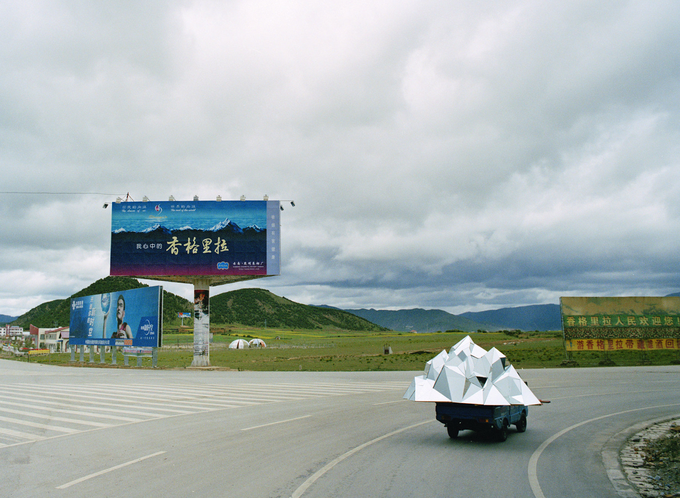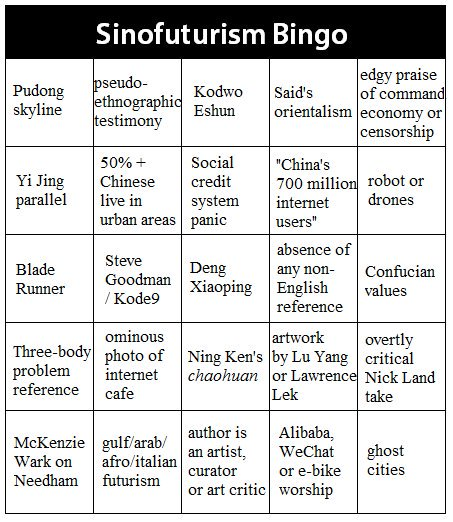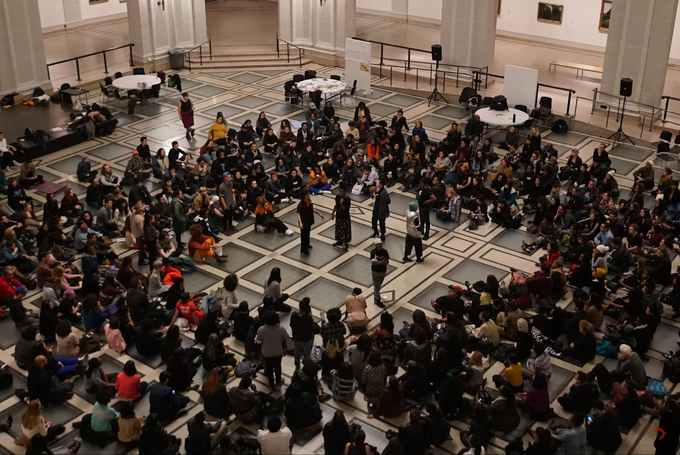Many definitions of continents rely on the distribution of tectonic plates. Geographers agree that there are no more than 8 continents and no fewer than 4.
 Patty Chang, Shangri-La, 2005, 40 minutes , single channel video installation.
Patty Chang, Shangri-La, 2005, 40 minutes , single channel video installation.
1: Where Asia Ends
You, reader, may be good at tests: where is the capital of Asia? Shangri-La is one answer—the setting of a mediocre novel/disastrous film, a chain of luxury resorts, an opportunistically-renamed Tibetan district of Yunnan, and a video artwork by the great Patty Chang. Like Shangri-La, Asia is less a real place than an idea of escape. Though political theorist Wang Hui is wrong to excuse Han colonialism in Tibet, he is right to insist “imagining Asia is a political project.” [1] Asia is always a matter of imagining, and as art workers, that makes it our business. The concept of Asia is too vague to use and too big to fail.
2: From One Asian To Another
The difference between “Asian” and “Asia,” between the biopolitical concept of race and the geopolitical concept of place, is a difference we have to carry. After all, most people—recalling that most people in the world are Asian—don’t discover that they are until they leave.
You can only be Asian outside of Asia. I write in America, where the bait-and-switch of race for place is accomplished every day by the sovereignly boring question, “Where are you from?” This question requires a tree version of human history where each person’s meaning depends on their origin. Bad geology naturalizes the concept of Asia—a quasi-continent nonsensically divided from Europe at its widest point—and bad biology naturalizes the political concept of Asian—a group that’s some 70% of the world population. The imagination of that which is Asian—in the double sense I described—relies on the scientific armature of natural selection or continental shift. However, this is a bad-faith reliance, since both geological and biological time are too slow to affect the rhythm of the histories to which we are bound.
Such histories are, instead, matters of the politics of culture. As the New York-based collective Eastern Standard Time puts it in a recent curatorial statement: “While overly expansive, orientalist definitions make it impossible to ascribe cultural, political, or geographical unity to Asia, EST is interested in its potential as a call to organize across a spectrum of experience.” To put it in historical context, for historian Prasenjit Duara, it begins primarily as an early 20th century cultural project, driven by elite intellectuals like Tenshin Okakura, Rabindranath Tagore, and Zhang Taiyan [2]. Culture is already political, but just wait until imperial states get involved: first Japanese militarism’s appropriation of anticolonial discourse (the East Asian Co-Prosperity Sphere), then American neoimperialism’s backyarding of the Pacific and containment of the USSR (Asia-Pacific), and even the left-leaning Non Aligned Movement’s attempt to build a non-Soviet socialist bloc (Afro-Asia), to name a few. In each of these contexts, the idea of the continent of Asia is mobilized to coordinate national ideas and serve state interests; so when Chen Kuan-hsing proposes “Asia as method,” we need to ask, which Asia?
Try this find-and-replace for size. For Asian as identifier, use “yellow,” as Yellow Jackets Collective does. For Asian as geotag, substitute “Eastern.” These old-fashioned words are problematic, but the problematics they addressed got grandfathered in—a proper noun doesn't fix improper behavior. Yellower than what? White supremacy. East of where? Western hegemony. To work a phrase of Yoko Tawada’s, Asia ends where Europe begins.
3: Asian Futurism is a Bad Idea
 Sinofuturism Bingo, by Gabriele de Seta, circulated on Facebook in 2017.
Sinofuturism Bingo, by Gabriele de Seta, circulated on Facebook in 2017.
Ironically, I’m late to the debate on Asian Futurism. [3] To recap recent discussions on Asian Futurism, Dawn Chan’s ambivalent formulation on Asian Futurism in a 2016 issue of Artforum called attention to the use of techno-orientalist tropes in contemporary art. For Chan, the association of futuristic imagery with Asian racialization exiled Asian Americans from the real present into a hypothetical future. In e-flux journal in 2017, Xin Wang responded to Chan’s question “is it possible to be othered across time?” by resisting the “implication that otherness necessarily operates from a place of deficiency.” Instead, otherness is radically heterogeneous, and perhaps not assimilable to a pre-existing hierarchy. Wang evinces a mistrust of identity-political projects that determine an artwork’s content based on the subject position of the artist.
Art-world internationalism thrusts subjects with different IDs and itineraries into the same suspended space; in this encounter, the uses of Asia are contradictory and overlapping. While it’s not fair to read authors as representatives, the forms of identity politics of these two authors seem to me to respond to different kinds of overdetermination, different ways that cultural different gets called on in the process of political subjection. I’ll be more direct. Whereas the Asian-American is overdetermined in biopolitical terms as a racial minority, the Chinese subject is overdetermined in geopolitical terms as a non-Westerner. This fragile distinction doesn’t account for the experiences of repatriates, migrants, or minorities, but it does bring into view the contrast between the diasporic desire for naturalization—the security of rights guaranteed by belonging (Chan)—and the cosmopolitan drive towards mobility—the freedom not to be from any one place (Wang).
As Chan notes, Asian Futurism is inspired by Afrofuturism. But temporal speculation works in an opposite way here. Whereas the latter resists a racist primitivism, the former accedes to the futurity of the yellow peril. After all, every cyberpunk plot, ever, goes like this: the future will be Asian, even though the heroes won’t be. As far as I can tell, the attempts to articulate Asian Futurism disaggregate into yellow futurism and Eastern futurism. Can they exceed the racial myths of model minority, on the one hand, and national projects of great-power status, on the other? Perhaps this either-or is too nicely drawn, but it seems to me that this split—a split that a term like diaspora can’t do justice to—is exactly the reason this question seemed important and interesting for a moment that isn’t quite over.
4: Self-Orientalism and Other Orientalisms
 Fatima Al-Qadiri, Asiatisch, EP, 2016
Fatima Al-Qadiri, Asiatisch, EP, 2016
Asian Futurism is inseparable from the divisions that cultural appropriation arouses along diasporic lines (think Ghost in the Shell or #kimonowednesdays). At stake is the relationship between representation and power—in other words, Orientalism.
Said’s critique of Orientalism leaves us with a Kantian formula: you can never really know Asia, but at least you can know that you can’t know it. In The Critique of Pure Reason, Kant squared the circle of idealism (which held that we could know reality as it really was) and empiricism (which held that we could only know what we experienced) by reasoning that though we couldn’t know the thing-in-itself, we could know our inability to know it. Similarly, if the critique of orientalism shows that our knowledge of the orient is in fact a product of the desire to dominate the subject of orientalism, then how do we account for the really existing Orient outside of our ideological drives? One way of short-circuiting this question is through self-Orientalism, and to equate the knowing subject and the known object are the same body. An infinite loop might crash the OS (Orientalism by Said). [4]
For example, Kuwaiti producer Fatima Al-Qadiri’s debut album Asiatisch pastiches the phonics of an imagined China, including vocal tracks in invented Mandarin. It dramatizes the difference between East and West Asia and stretches the “self” in self-Orientalizing to breaking point. By aestheticizing non-understanding, and even aestheticizing the awareness that one doesn’t understand, Asiatisch deepens the Kantian impasse.
In Larissa Pham’s erotic novel Fantasian, an East Asian woman at an elite college meets and starts an affair with her exact doppelganger, whose partner also has an identical twin—this begins a ménage-à-3-or-4 that ends in a mass suicide leaving behind only one. This love triangle and semiotic square literalizes and eroticizes “all Asians look the same,” while also allegorizing the homogenizing process of sexual objectification. Since difference is an epistemological problem, Pham’s kink is to simply destroy it.
“Asian” is a fetish category. Asiatisch invents an imaginary Asian language, and Fantasian an imaginary Asian body. They also imagine the disappearance of these other Asians, through distortion of immolation. If the labyrinthine logic of Orientalism creates insuperable distance between self and other, self-Orientalism should short-circuit this logic by collapsing self and other. Instead, it either preserves an absolute other (Al-Qadiri) or obliterates it (Pham). We never get to a relationship among ourselves, among each other.
5: Asian Solidarity Is a Good Idea

BUFU and Yellow Jackets Collective, Process/Mourn/Activate, a post-election gathering at the Brooklyn Museum, November 2016.
I’m suggesting that most Asian art today—which is not to say art by Asians, or art in Asia, but rather art that prioritizes the concept of Asia—is bad art with bad politics. I think that the conditions for abstracting a concept of Asia from the concrete experiences of Asians today are absent. At best, contemporary art that identifies as Asian is just a start.
Asian as an identity marker is “racial, racialized, but lacking the certainty of racial formations,” as Colleen Lye says, and as a political area, “an imperial region that exists uncomfortably with national subregions,” as Prasenjit Duara says. This looseness of an already-split concept means it’s lousy for analysis, but great for activism. (Incidentally and inversely, it also facilitates the cultural-capital opportunism of white creeps and rich East Asians.)
And because there is no shared Asian experience, even as a negatively felt one of oppression, such politics must assume intersection and coalition. Intersectionality, as Kimberlé Crenshaw theorizes it, centers multiply marginalized experiences and recognizes them as irreducible to their constitutive oppressions. For example, I suspect that Asian women share much more in experience than Asians “in general,” as the title of the now defunct project Sad Asian Girls (later Sad Asian Femmes) suggests, eulogized here.
Coalition must happen without analogy. Lye writes of how Asian racialization has an “analogical dependency” on the relationship between white supremacy and antiblackness. Frank Wilderson, in a different context, insists on the importance of refusing analogy (“my struggle is just like your struggle”) as the basis for the solidarity that it’s supposed to produce. For both writers, analogy erases the specificity of racialization. BUFU, a living archive of Afro-Asian solidarity, are modelling methods of documenting and experiencing the a complicated and interconnected history without equating black and yellow experiences.
If there’s a place for Asian art as I described it, it must be collective in process, focused on action, and oriented to the margins. Don’t settle for a futurism when we could have the future.
[1] Wang, Hui. The politics of imagining Asia. Harvard University Press, 2011.
[2] Tenshin Okakura, who wrote a book on tea, and begins Ideals of the East with “Asia is one.” And here's Rabindranath Tagore: "the central ideas of the messages of the great minds of Asia all through the ages was to make our world a little more beautiful.” And then, closer to home, are American art entrepreneurs like Ernest Fenollosa, who helped establish “Asian art as a legitimate and viable domain of high art, fit for museums and the art market.” (Why is it that the Asia Society is in New York?) Duara’s discussion is found in "Asia redux: Conceptualizing a region for our times," The Journal of Asian Studies 69.4 (2010): 963-983.
[3] The interest in futurisms is part of a decade-plus speculative flare-up. In the cyberpunk tradition, we also see silkpunk and oilpunk, for example—-the use of materials as synecdoches for regions is an indirect comment on racialized commodity capitalism. There are also finer-grained variants of ethnic futurisms we can look at: Gulf Futurism has already been thoroughly deconstructed by Mostafa Heddaya, whose dogmatic insistence on returning the analysis to power is always welcome. Sinofuturism, as Lawrence Lek proposes it, is another example that is hard to disentangle from state power and diasporic nostalgia.
[4] Because of its personal importance to my thinking on the subject, I should also mention another strategy for the escape from Orientalism: Reza Negarestani’s Cyclonopedia, which is best read as an attempt to crack Said using Deleuze and Guattari. This book bury the problem of representation of cultural difference within geovitalism; in other words, what matters isn’t so much what people see, so much as what things want.
This article could not have happened without conversations with—among others—Hera Chan, Celine Katzman, Devin Kenny, Nora Khan, Son Kit, and Anayvelyse Allen-Mossman. Misinterpretations and misjudgments remain the author’s own.


